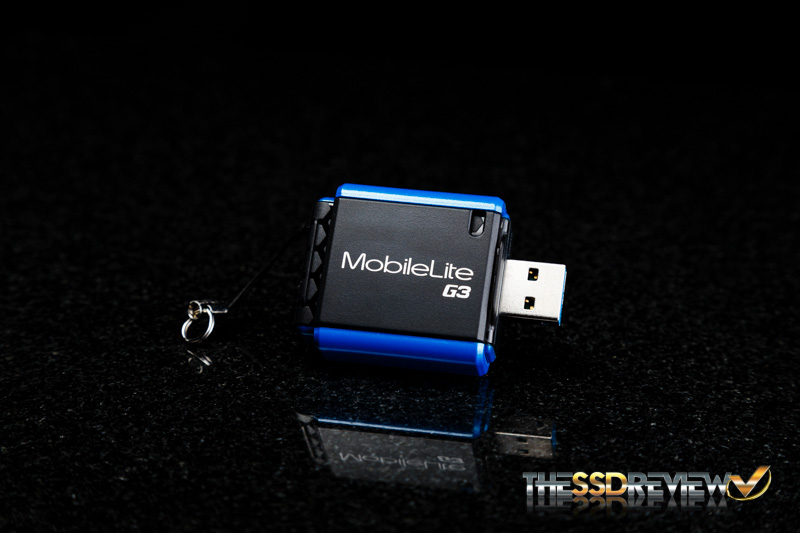FLASH MEDIA TEST PROTOCOL
In order to test the rated speeds of the card we choose to use a few popular synthetic benchmarks which include ATTO, CrystalDiskMark, and Anvil Storage Utilities Professional. Not only are we going to use these benchmarks, we are going to run a comparison against other cards I have in my bag and test in a real world use scenario. This should give us enough to confirm the rated specs and give us a more in-depth view on how it performs.
To connect the microSDXC card to our computer we have the Kingston MobileLite G3 USB 3.0 card reader. It is a compact and simple plug-and-play card reader that allows for USB 3.0 transfer speeds for any SD / SDHC / SDXC and microSD / SDHC / SDXC cards. It is a pretty good buy especially at only around $10 and will allow us to test the Kingston Ultimate at up to its max rated speeds.
ATTO DISK BENCHMARK VER. 2.47
ATTO Disk Benchmark is a relatively easy-to-use benchmark tool. ATTO Disk Benchmark relies on testing different file sizes with highly compressible data. Although this is not the best representation of media files which are, for the most part, highly incompressible, it is a good start and is still the main mechanism most manufacturers use to determine their product specifications. In our testing, we have left the benchmark settings to default.

ATTO verifies the rated 90MB/s read speeds, but we are around 2.2MB/s shy when it comes to the rated write speeds. The max write speed ATTO provides is 77.8MB/s
CRYSTALDISKMARK BENCHMARK VER. 3.0.3
Crystal Disk Mark is visually straightforward and is used for measuring the speeds at which your storage device reads and writes with random, mostly incompressible, data. Random data is more consistent with everyday use of a computer, such as transferring videos, pictures and music. Thus, this benchmark will be a better representation of speeds to expect on a video or stills camera over ATTO.

Crystal Disk Mark is showing us the same results as ATTO. The max read speed is 90MB/s and the max write speed is 77.66MB/s. Again, just shy of the rated write speed.
ANVIL’S STORAGE UTILITIES PROFESSIONAL 1.1.0
Anvil’s Storage Utilities is the best software program available for benchmarking flash media. Not only does it give an accurate look at transfer speeds and throughput, but also, it goes even further by identifying file sizes, disk access times, as well as system and device identification. It even has many extra features such as endurance torture testing and a TRIM button feature to manually trigger TRIM on supported devices.
Finally, Anvil’s Storage Utilities shows a max of 85.8MB/s for the read and a max of 70.28MB/s for the write. The speeds are slightly slower in this benchmark due to it testing fully compressed data.
 The SSD Review The Worlds Dedicated SSD Education and Review Resource |
The SSD Review The Worlds Dedicated SSD Education and Review Resource | 

I ordered it now at ebay i Hope i get an original. Ill use it with my new Sony xperia z3 Compact. Ill update how it perform. 😉
haha just bought one for my Z3C too. Perfect match, handles 4K brilliantly.
Its a really bad idea to buy any storage media off ebay, as its flooded with fake stuff.Its all fun and games until you realize your 64GB card is really just 4GB with hacked capacity.
Seriously a lot of fakes. I bought from fry’s and it was a fake Samsung. They refused to return because I didn’t have the box like it mattered! but really a lot of fakes.
Is it good enough to record 4k videos on Galaxy s5?
Is there anyway that you can do a benchmark with A1 SD? This would really help for people who want to use them in phones. Random read and write are what’s important!
Sean, You should use Kingston MobileLite G4 – significantly better speeds.
Bought this. HOLY…..this thing is wicked fast!
Important correction:
Actually, your results are incorrect in the region of blocks 32k OR less. I observed this behavior on my external(!) reader too. 64k and more gives >60MB/s, but 32k or less gives <9MB/s(read) and < 25 MB/s. (overlapped IO does not it affect much).
In internal reader:
neither (overlapped 1)
16k : 48/56, 32k: 57/63;
overlapped 10:
16k: 55/63. 32k:64/71
There is obvious continous speed developement if the card is in internal reader. There is a gap if the (my and your) reader is used between 32k and 64k